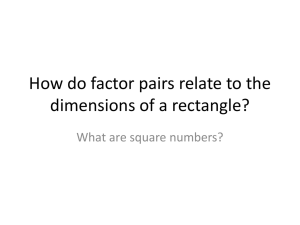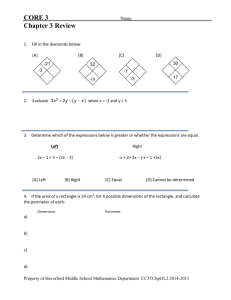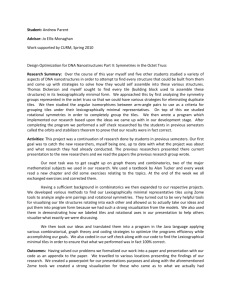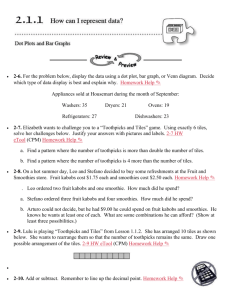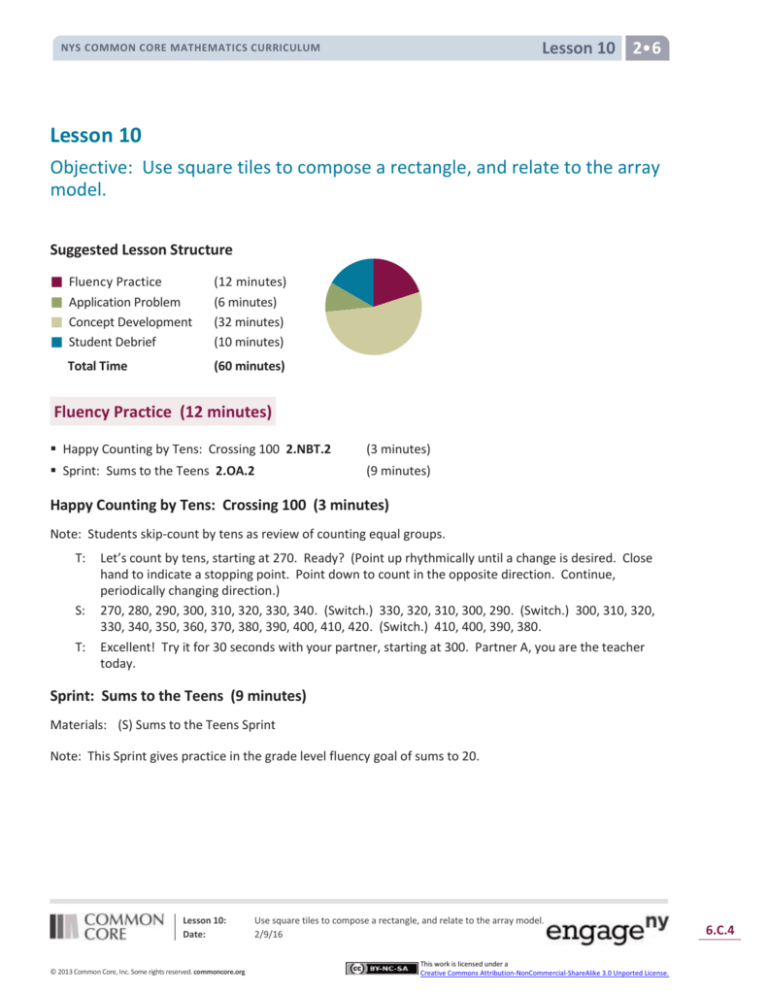
Lesson 10 2 6
NYS COMMON CORE MATHEMATICS CURRICULUM
Lesson 10
Objective: Use square tiles to compose a rectangle, and relate to the array
model.
Suggested Lesson Structure
Fluency Practice
Application Problem
Concept Development
Student Debrief
Total Time
(12 minutes)
(6 minutes)
(32 minutes)
(10 minutes)
(60 minutes)
Fluency Practice (12 minutes)
Happy Counting by Tens: Crossing 100 2.NBT.2
(3 minutes)
Sprint: Sums to the Teens 2.OA.2
(9 minutes)
Happy Counting by Tens: Crossing 100 (3 minutes)
Note: Students skip-count by tens as review of counting equal groups.
T:
S:
T:
Let’s count by tens, starting at 270. Ready? (Point up rhythmically until a change is desired. Close
hand to indicate a stopping point. Point down to count in the opposite direction. Continue,
periodically changing direction.)
270, 280, 290, 300, 310, 320, 330, 340. (Switch.) 330, 320, 310, 300, 290. (Switch.) 300, 310, 320,
330, 340, 350, 360, 370, 380, 390, 400, 410, 420. (Switch.) 410, 400, 390, 380.
Excellent! Try it for 30 seconds with your partner, starting at 300. Partner A, you are the teacher
today.
Sprint: Sums to the Teens (9 minutes)
Materials: (S) Sums to the Teens Sprint
Note: This Sprint gives practice in the grade level fluency goal of sums to 20.
Lesson 10:
Date:
© 2013 Common Core, Inc. Some rights reserved. commoncore.org
Use square tiles to compose a rectangle, and relate to the array model.
2/9/16
This work is licensed under a
Creative Commons Attribution-NonCommercial-ShareAlike 3.0 Unported License.
6.C.4
Lesson 10 2 6
NYS COMMON CORE MATHEMATICS CURRICULUM
Application Problem (6 minutes)
Note: The students have a chance to apply their
understanding of arrays to a real world context.
Sandy’s toy telephone has buttons arranged in 3 columns and
4 rows.
a. Draw a picture of Sandy’s telephone.
b. Write a number sentence to show the total number
of buttons on Sandy’s telephone.
Concept Development (32 minutes)
Materials: (S) Bag with 25 square tiles
Problem 1: Compose a rectangle with square tiles that has no gaps or overlaps.
T:
S:
T:
T:
S:
T:
S:
T:
S:
T:
S:
T:
S:
T:
S:
T:
S:
T:
Take out 10 tiles from your bag.
(Count out 10 tiles.)
Now put your tiles into 2 equal groups.
Organize your tiles into 2 equal rows like you did yesterday, but
this time leave no spaces between the rows.
(Create arrays.)
How many rows did you make?
2!
How many tiles are in each row?
5!
What number sentence can we use to find the total for two rows of
5?
5 + 5 = 10.
What do you notice about the shape of this array?
It has corners like an L. Pairs of sides are the same length.
It’s a rectangle!
Using the same tiles, make 2 columns of 5, and again, leave no
spaces between the columns to make a rectangle.
(Construct arrays.)
What number sentence can we use to find the total for 2 columns
of 5? Turn and talk.
5 + 5 = 10.
Are the number sentences and totals equal for both arrays?
Lesson 10:
Date:
© 2013 Common Core, Inc. Some rights reserved. commoncore.org
Use square tiles to compose a rectangle, and relate to the array model.
2/9/16
This work is licensed under a
Creative Commons Attribution-NonCommercial-ShareAlike 3.0 Unported License.
6.C.5
Lesson 10 2 6
NYS COMMON CORE MATHEMATICS CURRICULUM
S:
T:
S:
T:
S:
Yes!
How is that so? Talk to your partner.
It is the same rectangle, just turned on its side. It uses the same
number of tiles. It doesn’t matter whether you have 2 columns
of 5 or 2 rows of 5, because you have 2 groups of 5. It’s a
rectangle, too.
Is this shape also a rectangle?
Yes!
Repeat the above process with 15 tiles (5 by 3) and 12 tiles (3 by 4).
Problem 2: Compose a square from rows and columns.
T:
S:
T:
T:
S:
T:
S:
MP.4
T:
S:
T:
T:
S:
T:
S:
Let’s look at the array we just made (3 by 4). How can we change this rectangle from three columns
of 4 to have the same number of rows and columns? Talk to your partner.
Change it to 3 groups of 3. Add another column.
Take away one of the rows.
(Model taking away a row to make equal rows and
NOTES ON
columns.)
MULTIPLE MEANS OF
What do you notice about the shape of this array?
ACTION AND
It’s a square. The columns and rows are equal.
EXPRESSION:
There are 3 rows and 3 columns.
Large foam floor tiles can be a tool
to engage the class in a wholeLet’s see if we can make another square array. Talk to
group activity prior to giving the
your partner about your thinking as you use all 25 tiles
children small tiles to handle
from your bag to create an array with equal rows and
themselves.
columns. (Circulate and offer hints to encourage all
In the absence of tiles, square sticky
students to find the array.)
notes can be a good substitute for
I am going to start by making a row of 5, because I
this activity.
know I can count to 25 by five’s. I will separate the
tiles into groups until they are all equal.
What does your array look like?
Five rows of 5! Five columns and 5 rows! A square!
Now keep 16 tiles on your desk and put the rest in your
bag.
Create an array with equal rows and columns.
(Create equal rows and columns.)
What strategies did you use to figure out how many rows
and how many columns?
I started by creating groups of 2. Then I realized that if I
made groups of 4, I would have 4 groups. I know that
4 + 4 + 4 + 4 = 16, so I made 4 rows of 4. I made two
rows of eight and then saw it was a double of 2 rows of 4,
so I just moved half the tiles down.
Lesson 10:
Date:
© 2013 Common Core, Inc. Some rights reserved. commoncore.org
Use square tiles to compose a rectangle, and relate to the array model.
2/9/16
This work is licensed under a
Creative Commons Attribution-NonCommercial-ShareAlike 3.0 Unported License.
6.C.6
NYS COMMON CORE MATHEMATICS CURRICULUM
T:
S:
T:
S:
Lesson 10 2 6
So what do you know about making an array with equal rows and columns?
It’s like there have to be 5 groups with 5 objects in each one. I know that if you have 4 rows, then
there has to be 4 in each row. I know that you need the same number of groups and the number
in each group. You need the same number of tiles in the rows as in the columns. It’s a special
rectangle, a square!
Turn and talk, could we make a square array with 10 tiles?
No, because you can’t make equal rows and columns. Ten tiles can only be 2 rows of 5 or 1 row
of 10. Only certain numbers can make equal rows and columns.
Direct students to move on to the Problem Set.
Problem Set (10 minutes)
Students should do their personal best to complete the Problem Set within the allotted 10 minutes. For some
classes, it may be appropriate to modify the assignment by specifying which problems they work on first.
Some problems do not specify a method for solving. Students solve these problems using the RDW approach
used for Application Problems.
Student Debrief (10 minutes)
Lesson Objective: Use square tiles to compose a rectangle, and relate to the array model.
The Student Debrief is intended to invite reflection and active processing of the total lesson experience.
Invite students to review their solutions for the Problem
Set. They should check work by comparing answers with a
partner before going over answers as a class. Look for
misconceptions or misunderstandings that can be
addressed in the Debrief. Guide students in a
conversation to debrief the Problem Set and process the
lesson.
You may choose to use any combination of the questions
below to lead the discussion.
For Problems 1(a) and (b), share your rectangles
with a partner and describe them using the
words rows and columns. How do your
rectangles match the repeated addition number
sentences?
For Problems 2(a) and (b), share your rectangles
with a partner. How are rectangles composed of
equal groups? How does your rectangle match
your number sentence?
Lesson 10:
Date:
© 2013 Common Core, Inc. Some rights reserved. commoncore.org
Use square tiles to compose a rectangle, and relate to the array model.
2/9/16
This work is licensed under a
Creative Commons Attribution-NonCommercial-ShareAlike 3.0 Unported License.
6.C.7
NYS COMMON CORE MATHEMATICS CURRICULUM
Lesson 10 2 6
For Problem 3, explain to your partner how you
arranged the tiles into a rectangle. How did
making equal rows and columns help you to
construct the rectangle?
Squares are special rectangles that have the same
number of rows and columns. In Problem 4, you
changed a rectangle into a square by removing a
column. Is there a different way to make a square
from the array?
What repeated addition sentence would we use
to describe a square array with rows of 2? 3? 4?
5? What do you notice?
Why don’t we relate triangles to an array model?
Exit Ticket (3 minutes)
After the Student Debrief, instruct students to complete
the Exit Ticket. A review of their work will help you assess
the students’ understanding of the concepts that were
presented in the lesson today and plan more effectively
for future lessons. You may read the questions aloud to
the students.
Note: In order to assess student understanding on today’s exit ticket, walk around and directly observe
students as they work with the tiles. Take note of how students are building their arrays. Look for
understanding of rows and columns as well as the importance of building with no gaps or spaces between the
tiles.
Lesson 10:
Date:
© 2013 Common Core, Inc. Some rights reserved. commoncore.org
Use square tiles to compose a rectangle, and relate to the array model.
2/9/16
This work is licensed under a
Creative Commons Attribution-NonCommercial-ShareAlike 3.0 Unported License.
6.C.8
NYS COMMON CORE MATHEMATICS CURRICULUM
Lesson 10:
Date:
© 2013 Common Core, Inc. Some rights reserved. commoncore.org
Lesson 10 Sprint 2•6
Use square tiles to compose a rectangle, and relate to the array model.
2/9/16
This work is licensed under a
Creative Commons Attribution-NonCommercial-ShareAlike 3.0 Unported License.
6.C.9
NYS COMMON CORE MATHEMATICS CURRICULUM
Lesson 10:
Date:
© 2013 Common Core, Inc. Some rights reserved. commoncore.org
Lesson 10 Sprint 2•6
Use square tiles to compose a rectangle, and relate to the array model.
2/9/16
This work is licensed under a
Creative Commons Attribution-NonCommercial-ShareAlike 3.0 Unported License.
6.C.10
Lesson 10 Problem Set 2•6
NYS COMMON CORE MATHEMATICS CURRICULUM
Name
Date
Use your square tiles to construct the following rectangles with no gaps or overlaps on
your work mat. Write a repeated addition sentence to match each construction.
1.
a. Construct a rectangle with 2 rows of 3 tiles.
__________________________________
b. Construct a rectangle with 2 columns of 3 tiles.
__________________________________
2.
a. Construct a rectangle with 5 rows of 2 tiles.
__________________________________
b. Construct a rectangle with 5 columns of 2 tiles.
__________________________________
Lesson 10:
Date:
© 2013 Common Core, Inc. Some rights reserved. commoncore.org
Use square tiles to compose a rectangle, and relate to the array model.
2/9/16
This work is licensed under a
Creative Commons Attribution-NonCommercial-ShareAlike 3.0 Unported License.
6.C.11
NYS COMMON CORE MATHEMATICS CURRICULUM
Lesson 10 Problem Set 2•6
3.
a. Construct a rectangle of 9 tiles so that the rows are the same size as the
columns.
__________________________________
b. Construct a rectangle of 16 tiles that has equal rows and columns.
__________________________________
4.
a. What shape is the array pictured below? _________________________
b. Redraw the above shape with one column removed in the space below.
c. What shape is the array now? _________________________
Lesson 10:
Date:
© 2013 Common Core, Inc. Some rights reserved. commoncore.org
Use square tiles to compose a rectangle, and relate to the array model.
2/9/16
This work is licensed under a
Creative Commons Attribution-NonCommercial-ShareAlike 3.0 Unported License.
6.C.12
Lesson 10 Exit Ticket 2•6
NYS COMMON CORE MATHEMATICS CURRICULUM
Name
Date
Use your square tiles to construct the following arrays with no gaps or overlaps on this
sheet. Write a repeated addition sentence to match your construction.
1.
a. Construct a rectangle with 2 rows of 5 tiles.
b. Write the repeated addition sentence: ___________________________
2.
a. Construct a rectangle with 5 columns of 2 tiles.
b. Write the repeated addition sentence: ___________________________
Lesson 10:
Date:
© 2013 Common Core, Inc. Some rights reserved. commoncore.org
Use square tiles to compose a rectangle, and relate to the array model.
2/9/16
This work is licensed under a
Creative Commons Attribution-NonCommercial-ShareAlike 3.0 Unported License.
6.C.13
NYS COMMON CORE MATHEMATICS CURRICULUM
Name
Lesson 10 Homework 2•6
Date
Cut out the square tiles below. Use them as needed to help construct the following arrays with
no gaps or overlaps. Write a repeated addition sentence on the line that matches each
construction.
1. a. Construct a rectangle with 2 rows of 4 tiles.
Write the repeated addition sentence.
b. Construct a rectangle with 2 columns of 4
tiles. Write the repeated addition sentence.
____________________________________
_________________________________
2. a. Construct a rectangle with 3 rows of 2 tiles.
Write the repeated addition sentence.
b. Construct a rectangle with 3 columns of 2
tiles. Write the repeated addition sentence.
____________________________________
_________________________________
3. a. Construct a rectangle using 10 tiles.
Write the repeated addition sentence.
b. Construct a rectangle using 12 tiles.
Write the repeated addition sentence.
____________________________________
_________________________________
Lesson 10:
Date:
© 2013 Common Core, Inc. Some rights reserved. commoncore.org
Use square tiles to compose a rectangle, and relate to the array model.
2/9/16
This work is licensed under a
Creative Commons Attribution-NonCommercial-ShareAlike 3.0 Unported License.
6.C.14
NYS COMMON CORE MATHEMATICS CURRICULUM
Lesson 10 Homework 2•6
4.
a. What shape is the array pictured below? ___________________________
b. Redraw the above shape with one more column in the space below.
c. What shape is the array now? _______________________________
d. Draw a different array of tiles that is the same shape as 4(c).
Lesson 10:
Date:
© 2013 Common Core, Inc. Some rights reserved. commoncore.org
Use square tiles to compose a rectangle, and relate to the array model.
2/9/16
This work is licensed under a
Creative Commons Attribution-NonCommercial-ShareAlike 3.0 Unported License.
6.C.15


